1.1 Overview of the Manual’s Purpose
The US Navy Dive Manual is the authoritative guide for diving operations, ensuring safety and efficiency in military diving. It includes updated decompression tables, emergency procedures, and communication methods like line-pull signals, reflecting the Navy’s commitment to advancing diving practices while maintaining rigorous safety standards.
The US Navy Dive Manual serves as the primary guide for diving operations, providing detailed protocols for safe and effective diving. It outlines procedures for pre-dive checks, emergency responses, and decompression, ensuring adherence to safety standards. The manual also covers advanced techniques and communication methods, such as line-pull signals, to enhance teamwork and efficiency. Regular updates incorporate new algorithms and technologies, making it an essential resource for both training and operational diving.
1.2 Historical Background of the Manual
The US Navy Dive Manual traces its origins to the early 20th century, evolving to standardize diving practices. Initially focused on basic procedures, it expanded to include decompression tables and safety protocols. Key revisions, such as the introduction of the VVal-18 algorithm for air decompression, reflect advancements in diving science. The manual has historically adapted to technological and operational demands, ensuring Navy divers operate safely and effectively in various environments, from deep-sea missions to specialized operations like salvage and recovery.
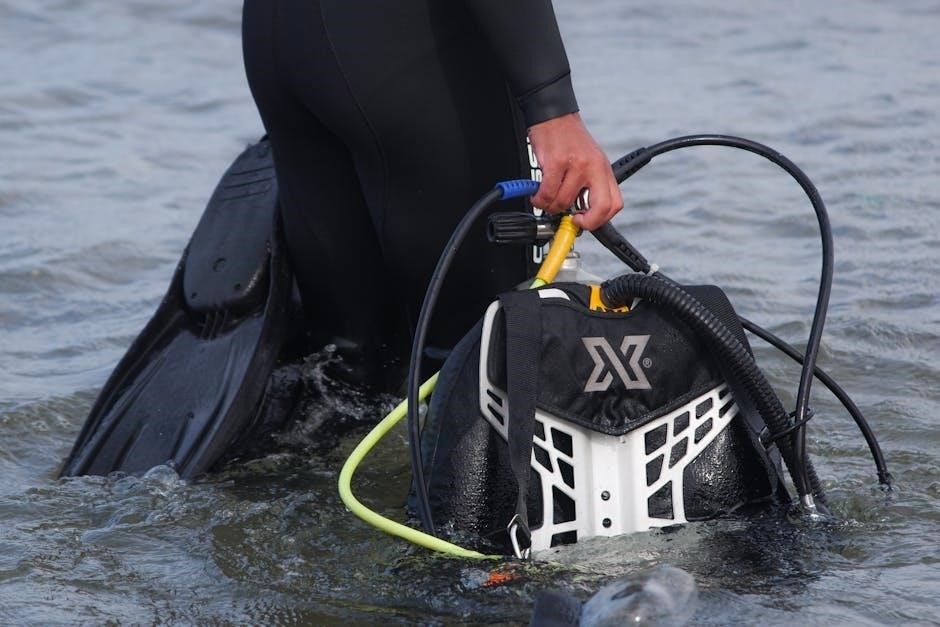
Diving Safety Protocols
Diving safety protocols ensure secure underwater operations. Key elements include pre-dive checks, emergency procedures, and decompression tables. The manual emphasizes the use of updated algorithms, like VVal-18, and clear communication methods such as line-pull signals to maintain diver safety and operational efficiency.
2.1 Pre-Dive Safety Checks
Pre-dive safety checks are critical to ensure safe underwater operations. The manual outlines detailed procedures for inspecting diving gear, testing communication equipment, and verifying air supply systems. Additionally, environmental assessments and diver medical screenings are conducted to identify potential risks. These checks minimize hazards and ensure all equipment functions properly before the dive begins, adhering to strict safety protocols outlined in the US Navy Dive Manual.
2.2 Emergency Procedures for Divers
Emergency procedures for divers are vital for ensuring safe outcomes during critical situations. The manual provides clear protocols for managing emergencies such as air supply failures, equipment malfunctions, and diver injuries. Rescue operations and rapid ascent procedures are detailed, emphasizing quick and effective responses. These guidelines ensure divers and support teams can act decisively, minimizing risks and preventing further complications in high-stress underwater scenarios.
2.3 Air Decompression Tables and Procedures
The US Navy Dive Manual includes detailed air decompression tables and procedures to prevent decompression sickness. These tables, developed using algorithms like VVal-18, provide safe ascent schedules for divers based on depth and time. Proper adherence ensures gradual gas pressure equalization, minimizing risks. The manual outlines step-by-step procedures for ascent, safety stops, and emergency decompression, ensuring divers can safely return to the surface after underwater operations.

Diving Equipment and Gear
The US Navy Dive Manual details essential diving equipment, including scuba gear, surface-supplied systems, and accessories. Proper gear maintenance is emphasized for safety and reliability.
3.1 Scuba Gear and Accessories
Scuba gear is essential for underwater operations, including regulators, air tanks, buoyancy control devices (BCDs), and diving computers. Accessories like dive lights, knives, and underwater communication devices enhance safety and efficiency. The manual emphasizes proper inspection and maintenance of all equipment to ensure reliability and diver safety during operations. Adherence to these standards is critical for successful missions and preventing equipment failure underwater.
3.2 Surface-Supplied Diving Equipment
Surface-supplied diving equipment provides a continuous air supply from the surface, enhancing safety and extending dive duration. Key components include umbilical hoses, full-face masks, and environmental protection suits. The system allows real-time communication between divers and surface teams, improving coordination. Regular maintenance and inspection of hoses, valves, and connections are critical to prevent failures. This equipment is vital for deep or extended dives, ensuring divers remain supplied with air and connected to the surface support team for emergency responses.
3.4 Maintenance and Inspection of Diving Gear
Regular maintenance and inspection of diving gear are crucial for operational safety; Equipment must be checked for damage, corrosion, and wear. Regulators, hoses, and valves are inspected for proper function, while environmental suits and masks are examined for integrity. Post-dive rinsing and storage protocols prevent degradation. Detailed logs and checklists ensure compliance with standards, minimizing risks during operations. Proper maintenance extends equipment lifespan and ensures reliability in critical diving scenarios.
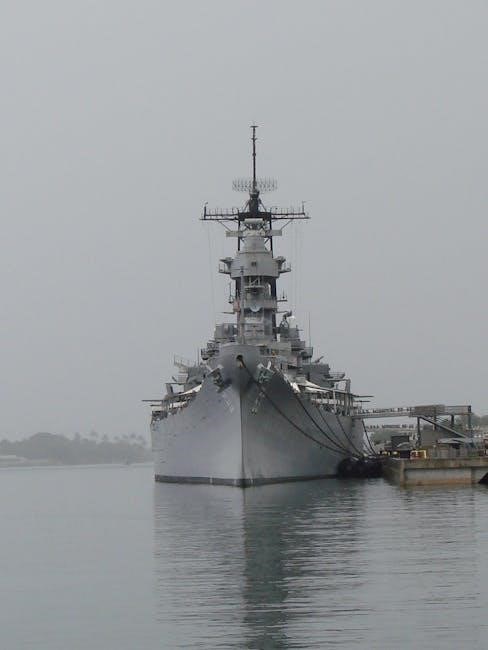
Diving Techniques and Procedures
This section outlines essential diving techniques and standardized procedures for safe and effective underwater operations, including ascent, descent, and emergency protocols, ensuring operational efficiency and diver safety.
4.1 Basic Diving Techniques
Basic diving techniques form the foundation of safe and effective underwater operations. These include proper breathing methods, buoyancy control, and navigation skills. Divers learn to manage their air supply efficiently, perform safety checks, and maintain communication with their team. The manual emphasizes the importance of gradual descent and ascent to prevent pressure-related injuries. These fundamental techniques ensure that divers can operate confidently in various underwater environments, laying the groundwork for more advanced operations.
4.2 Advanced Diving Techniques
Advanced diving techniques involve specialized skills for complex underwater operations. These include navigation using underwater landmarks, operating specialized tools, and managing challenging conditions. Divers learn to use rebreathers for extended missions and navigate using compasses or GPS. The manual highlights the use of new decompression tables and algorithms, such as VVal-18, to enhance safety. Advanced techniques also cover emergency scenarios, emphasizing rapid response and teamwork. These skills enable divers to handle high-risk missions effectively, ensuring mission success in diverse environments.
4.3 Line-Pull Signals and Communication
Line-pull signals are crucial for diver-tender communication. The manual outlines standard signals, such as one pull for “okay” and two pulls for “stop.” Divers and tenders rely on these signals to coordinate actions underwater. The system ensures clear communication without verbal interaction, enhancing safety. Proper use of line-pull signals is emphasized in training, allowing teams to respond effectively to changing conditions. This method is vital for maintaining synchronization and ensuring successful mission outcomes in various diving scenarios.
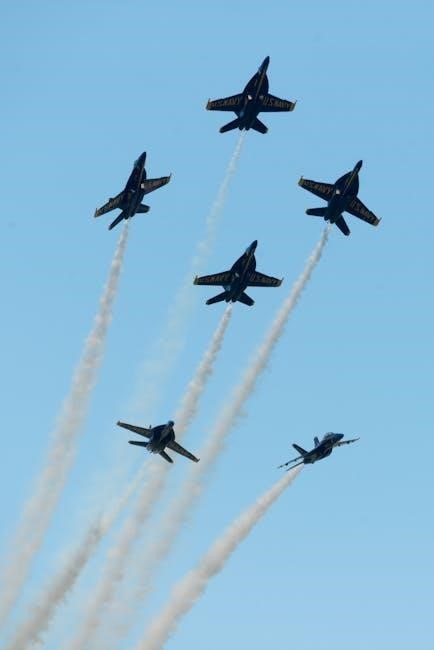
Training and Certification
The Navy Diver Training Program is rigorous, ensuring divers master safety protocols, equipment usage, and emergency procedures. Certification requires passing comprehensive tests, demonstrating proficiency in all aspects of diving operations.
5.1 Navy Diver Training Program
The Navy Diver Training Program is a comprehensive course designed to equip divers with essential skills. It covers foundational diving techniques, safety protocols, and the use of advanced equipment. Trainees learn emergency procedures, including rescue operations and decompression practices. The program emphasizes physical conditioning, mental discipline, and teamwork, ensuring graduates are fully prepared for the challenges of naval diving operations and can perform effectively in various underwater environments.
5.2 Certification Requirements for Navy Divers
Certification for Navy divers involves rigorous training, practical assessments, and adherence to strict safety protocols. Divers must complete the Navy Diver Training Program, pass written and practical exams, and demonstrate proficiency in underwater operations. Medical evaluations ensure fitness for duty, and certifications must be renewed periodically. The process emphasizes adherence to the US Navy Dive Manual standards, ensuring divers are fully qualified to perform their roles safely and effectively in various operational environments.
5.3 Continuous Training and Skill Development
Continuous training is essential for Navy divers to maintain and enhance their skills. The program includes regular drills, simulations, and real-world exercises to ensure proficiency in advanced techniques. Divers learn to adapt to new technologies and operational challenges, with a focus on safety and mission readiness. Ongoing education and practical application of the US Navy Dive Manual ensure divers stay updated on the latest protocols and procedures, fostering a culture of continuous improvement and operational excellence.
Environmental Considerations
Environmental factors like water temperature, pressure, and altitude significantly impact diving safety. The manual provides guidelines for operations in diverse conditions, ensuring safe practices and mission success.
6.1 Diving in Cold Water Environments
Diving in cold water environments requires special precautions to prevent hypothermia and maintain equipment functionality. The manual outlines thermal insulation guidelines, water temperature limits, and specific protocols for cold-water operations to ensure diver safety and mission effectiveness in such challenging conditions.
6.2 Diving in Shallow and Deep Waters
Diving in shallow and deep waters presents unique challenges. The manual provides detailed protocols for both environments, emphasizing depth-specific safety measures. Shallow water diving requires attention to visibility and currents, while deep-water operations focus on pressure management and equipment functionality. Divers must adhere to strict depth limits and ascend gradually to avoid complications, ensuring safe and effective operations in all water conditions.
6.3 Diving at High Altitudes
Diving at high altitudes requires specialized protocols due to reduced water pressure and increased risk of altitude sickness. The manual outlines specific adjustments for decompression tables and emergency procedures in high-altitude environments. Divers must account for lower atmospheric pressure, which affects gas absorption and bubble formation. Proper acclimatization and modified ascent rates are critical to prevent decompression sickness. The manual also emphasizes the importance of pre-dive medical checks and equipment calibration for safe operations in these challenging conditions.

Medical Aspects of Diving
The US Navy Dive Manual emphasizes medical screening, injury management, and decompression sickness prevention. It provides guidelines for bubble formation and emergency treatments, ensuring diver health and safety. Proper medical protocols are essential for preventing and treating diving-related injuries, with a focus on prompt intervention and post-dive care to minimize risks and ensure long-term diver well-being. Regular check-ups and adherence to safety standards are critical components of the manual’s medical guidelines.
7.1 Medical Screening for Divers
The US Navy Dive Manual outlines rigorous medical screening for divers to ensure fitness for duty. Physical exams, medical history reviews, and risk assessments are conducted to identify conditions that could pose risks underwater. Screening includes evaluations for respiratory, cardiovascular, and neurological health, as well as vision and hearing tests. Divers must meet strict criteria to prevent complications like decompression sickness. Medical professionals follow standardized protocols to certify divers, ensuring safe and effective operations. Regular screenings are mandatory to maintain diving eligibility and overall health. This process is critical for preventing diving-related injuries and fatalities.
7.2 Managing Diving-Related Injuries
The US Navy Dive Manual provides detailed protocols for managing diving-related injuries, emphasizing immediate care and prevention of complications. Divers are trained to recognize symptoms of decompression sickness, nitrogen narcosis, and oxygen toxicity. Treatment includes administering oxygen, controlling pain, and stabilizing the injured diver. Hyperbaric chambers are often used to alleviate decompression-related conditions. Proper first aid and rapid evacuation to medical facilities are critical. Continuous training ensures divers and support teams can respond effectively to emergencies, minimizing long-term health impacts and ensuring safe recovery. These practices are essential for maintaining diver health and operational readiness;
7.3 Bubble Formation and Decompression Sickness
Bubble formation occurs when gas dissolved in the bloodstream rapidly expands during ascent, leading to decompression sickness. The US Navy Dive Manual addresses this by incorporating the VVal-18 algorithm in decompression tables, which calculates safe ascent rates to minimize bubble formation. Symptoms include joint pain, fatigue, and skin rashes, often requiring immediate medical intervention. Proper training and adherence to decompression procedures are critical to prevent this condition, ensuring diver safety and operational effectiveness. Continuous updates in the manual reflect advancements in understanding and mitigating decompression risks.
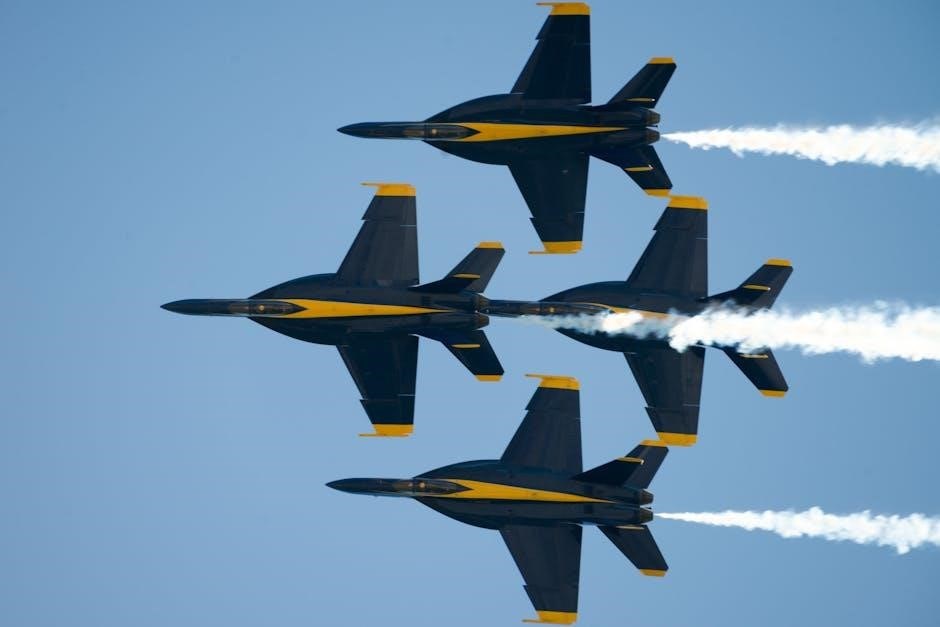
Communication and Teamwork
Effective communication is vital in Navy diving. Line-pull signals enable reliable interaction between divers and tenders, ensuring safety and coordination during underwater operations.
8.1 Underwater Communication Techniques
Underwater communication in the US Navy relies on line-pull signals, hand signals, and full-face masks. Line-pull signals enable divers and tenders to communicate through tugs on the umbilical line. Hand signals are used for basic communication, while full-face masks allow voice communication in clear conditions. Acoustic devices and light signals are also employed for reliability in various water conditions, ensuring safe and coordinated diving operations. These methods require precise protocols and training to maintain effective teamwork and safety underwater.
8.2 Team Coordination During Dives
Team coordination is critical for safe and efficient diving operations. Divers, tenders, and supervisors must clearly communicate and follow established protocols. Roles are defined before the dive, with pre-dive briefings outlining tasks and safety measures. During dives, visual contact and hand signals ensure coordination, while line-pull signals provide critical communication between divers and the surface team. Post-dive debriefings review operations, reinforcing teamwork and identifying areas for improvement. This structured approach ensures seamless execution and adherence to safety standards.
8.3 Hand Signals and Gestures
Hand signals and gestures are essential for underwater communication, ensuring clarity and safety. The US Navy Dive Manual outlines standardized signals for divers and tenders, such as the “okay” sign, directional signals, and emergency alerts. These gestures are practiced during training to ensure quick recognition and response. Proper use of hand signals minimizes misunderstandings and enhances teamwork, allowing divers to communicate effectively in environments where verbal communication is impossible. The manual emphasizes consistent use of these signals to maintain operational safety and efficiency.
Emergency Protocols
The US Navy Dive Manual details critical emergency procedures, including rescue operations, emergency ascension protocols, and post-dive medical checks, ensuring diver safety and operational efficiency in crisis situations.
9.1 Rescue Operations and Procedures
The US Navy Dive Manual outlines systematic rescue operations, emphasizing quick response and diver safety. It includes the use of surface-supplied equipment and line-pull signals for communication. Standby divers are trained to execute swift rescues, adhering to decompression procedures to prevent further injuries. The manual also covers underwater rescue techniques, ensuring minimal fatigue and maximizing efficiency during critical situations.
9.2 Emergency Ascension and Surface Procedures
The US Navy Dive Manual details procedures for emergency ascension, prioritizing diver safety and preventing decompression sickness. It outlines protocols for gradual ascent, buddy system assistance, and surface recovery. Divers are trained to avoid rapid ascents and utilize backup breathing systems. Once surfaced, immediate medical evaluation is mandatory to assess for injuries or decompression-related issues, ensuring comprehensive care and minimizing risks associated with emergency situations.
9.3 Post-Dive Medical Checks
Post-dive medical checks are critical to ensure diver safety and detect potential health issues. The US Navy Dive Manual mandates thorough examinations by medical personnel to identify symptoms of decompression sickness or other injuries. These checks include monitoring vital signs, assessing physical condition, and reviewing dive profiles. Immediate medical intervention is required if symptoms arise, ensuring timely treatment and preventing long-term health complications. These procedures are essential for maintaining diver health and operational readiness.

Historical Revisions and Updates
The US Navy Dive Manual has undergone significant revisions, with the 2008 update introducing the VVal-18 algorithm for decompression tables, enhancing safety and operational efficiency.
10.1 Key Revisions in the Manual
The US Navy Dive Manual has seen crucial updates, particularly the introduction of the VVal-18 algorithm in 2008, which improved decompression procedures. This revision enhanced diver safety by providing more accurate tables for various dive conditions. Additionally, the manual now includes updated protocols for emergency ascents and expanded guidelines for diving in extreme environments, such as Arctic regions. These changes reflect the Navy’s commitment to staying at the forefront of diving technology and safety standards.
The manual incorporates the VVal-18 algorithm, replacing older models with more precise calculations for safe ascent rates and decompression stops. New air decompression tables address various depth and time exposures, reducing risks of decompression sickness. These updates ensure safer dives across different environments and conditions, reflecting advancements in diving science and technology. The revised tables are now standard for all Navy diving operations, enhancing overall safety and operational efficiency for divers.
10.3 Evolution of Diving Practices
The US Navy Dive Manual reflects significant advancements in diving practices, adapting to new technologies and environmental challenges. Revised protocols now include updated safety measures for cold water and high-altitude diving. The integration of AI and robotics in underwater operations has streamlined tasks, reducing risks. These changes emphasize the Navy’s commitment to modernizing diving techniques while maintaining rigorous safety standards. The manual’s evolution ensures divers are equipped to handle diverse missions effectively, from salvage operations to explosive ordnance disposal, in varying environments.

Specialized Diving Operations
The US Navy Dive Manual covers specialized operations like salvage and recovery diving, submarine rescue, and explosive ordnance disposal, ensuring divers are trained for complex underwater missions.
11.1 Salvage and Recovery Diving
Salvage and recovery diving involves specialized techniques to retrieve submerged objects, such as aircraft, vehicles, or equipment. The US Navy Dive Manual outlines procedures for assessing underwater sites, securing debris, and safely lifting items to the surface. Divers use advanced tools and equipment, such as hydraulic cutting tools and lifting bags, to perform these operations. The manual also emphasizes safety protocols to prevent accidents during complex recovery missions, ensuring efficient and successful outcomes in challenging environments.
11.2 Submarine Rescue Operations
Submarine rescue operations are critical for saving crews from stranded submarines. The US Navy Dive Manual details procedures for locating, assessing, and rescuing submariners. Divers play a key role in establishing communication, delivering emergency supplies, and evacuating personnel using pressurized rescue modules. The manual emphasizes rapid response, precise coordination, and safety to minimize risks during these high-stakes missions, ensuring the survival of sailors in distress. These operations require advanced training and specialized equipment to execute successfully.
11.3 Explosive Ordnance Disposal (EOD) Diving
Explosive Ordnance Disposal (EOD) diving involves specialized techniques to neutralize underwater threats. The US Navy Dive Manual provides detailed protocols for EOD divers, including risk assessment, equipment usage, and detonation procedures. These operations require precise communication and teamwork to ensure safety. The manual also covers training methods and emergency response plans, highlighting the critical role of EOD divers in maintaining maritime security and protecting personnel and assets from explosive hazards. Their work is essential for mission success in high-risk environments.
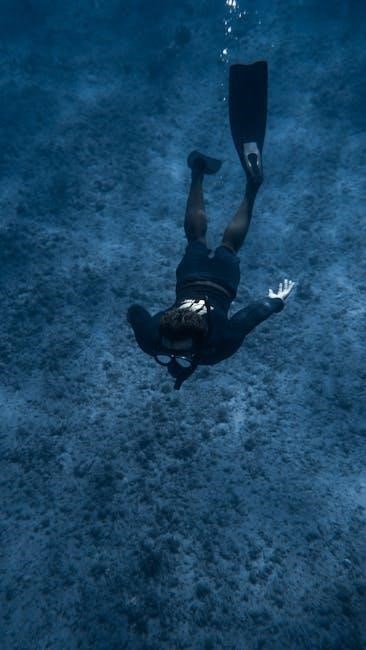
Future Developments in Navy Diving
Future advancements in Navy diving may include AI integration, advanced robotics, and improved diving gear. These innovations aim to enhance safety, efficiency, and mission capabilities for divers.
12.1 Advancements in Diving Technology
Advancements in diving technology focus on improving safety and operational efficiency. The VVal-18 algorithm enhances decompression calculations, reducing risks. Real-time monitoring systems track diver health and environmental conditions. Enhanced rebreathers and energy-efficient thrusters are being developed. Additionally, AI-driven systems optimize dive planning and post-dive analysis, ensuring safer and more effective missions. These innovations reflect the Navy’s commitment to staying at the forefront of diving technology, improving both diver performance and mission success rates.
12.2 Integration of AI and Robotics
The integration of AI and robotics revolutionizes Navy diving operations by enhancing precision and safety. Autonomous underwater systems perform complex tasks like inspections and salvage. AI-driven analytics optimize dive planning and real-time adjustments, improving mission efficiency. Robotics enable safer operations in hazardous environments, reducing diver exposure to risks. This integration aligns with the Navy’s goal to modernize capabilities, ensuring superior performance in diverse operational scenarios while maintaining operational excellence and technological superiority.
12.3 Enhanced Training Methods
Enhanced training methods in the US Navy Dive Manual focus on advancing diver proficiency through cutting-edge techniques. Virtual reality simulations and immersive training environments replicate real-world scenarios, improving adaptability and decision-making. Personalized learning plans and real-time feedback tools ensure tailored skill development. These innovations, combined with collaborative training exercises, enhance team coordination and operational readiness, ensuring divers are prepared for the most challenging missions while maintaining the highest safety standards and operational excellence.






